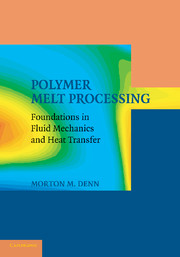Book contents
- Frontmatter
- Contents
- Preface
- 1 Polymer Processing
- 2 Fundamentals
- 3 Extrusion
- 4 Temperature and Pressure Effects in Flow
- 5 The Thin Gap Approximation
- 6 Quasi-Steady Analysis of Mold Filling
- 7 Fiber Spinning
- 8 Numerical Simulation
- 9 Polymer Melt Rheology
- 10 Viscoelasticity in Processing Flows
- 11 Stability and Sensitivity
- 12 Wall Slip and Extrusion Instabilities
- 13 Structured Fluids
- 14 Mixing and Dispersion
- Postface
- Author Index
- Subject Index
- Plate section
- References
5 - The Thin Gap Approximation
Published online by Cambridge University Press: 05 June 2012
- Frontmatter
- Contents
- Preface
- 1 Polymer Processing
- 2 Fundamentals
- 3 Extrusion
- 4 Temperature and Pressure Effects in Flow
- 5 The Thin Gap Approximation
- 6 Quasi-Steady Analysis of Mold Filling
- 7 Fiber Spinning
- 8 Numerical Simulation
- 9 Polymer Melt Rheology
- 10 Viscoelasticity in Processing Flows
- 11 Stability and Sensitivity
- 12 Wall Slip and Extrusion Instabilities
- 13 Structured Fluids
- 14 Mixing and Dispersion
- Postface
- Author Index
- Subject Index
- Plate section
- References
Summary
Introduction
The preceding chapters addressed flows with a single velocity component that is parallel to the conduit walls. Most confined polymer processing operations are characterized by flows in thin gaps, but in many cases the walls are not parallel, so there must be more than one component of velocity. It is often the case, however, that the gap between the confining surfaces changes slowly in the direction of mean flow, a situation we call nearly parallel. Such flows can be treated analytically, and we can gain considerable insight into process performance and design. We will illustrate the approach in this chapter with an application of polymer coating of a sheet, but the methodology applies equally well to calendaring, extrusion, and compression and injection molding.
The analysis of nearly parallel flows originated in the study of problems of lubrication, and the approach is often called the lubrication approximation. The terminology is unfortunate from our perspective, given that this approach is at the heart of all analytical treatments of polymer processing operations – we would prefer that it be called the polymer processing approximation – but the historical name is well established. The major figure in the analysis of lubrication flows was Osborne Reynolds, and one widely used form of the resulting equations is often called the Reynolds lubrication equation.
Basic Equations, Newtonian Liquid
We restrict ourselves to two-dimensional flows, where all changes occur in the xy plane and there is no flow in the “neutral” z direction.
- Type
- Chapter
- Information
- Polymer Melt ProcessingFoundations in Fluid Mechanics and Heat Transfer, pp. 65 - 71Publisher: Cambridge University PressPrint publication year: 2008



